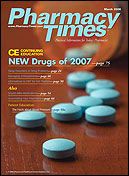Publication
Article
Pharmacy Times
ARTHRITIS WATCH
Chocolate: Helps the Heart,But Bad for Bones?
In the wake of evidence that consuming chocolate canreduce the risk of certain heart ailments, new studies areshowing that the tasty treat may not be so good for the bones.The findings showed that older women who ate some chocolateevery day had weaker, thinner bones than those who atechocolate less frequently—the relationship was independentof other dietary factors. Although chocolates are rich inflavonoids, they are high in oxalate, which blocks calciumabsorption, and sugar. The findings were published in theJanuary issue of the American Journal of Clinical Nutrition.
Researchers from the University of Western Australia Schoolof Medicine and Pharmacology in Perth studied the data on1001 women aged 70 to 85 who were participating in a studyon calcium supplementation and fracture risk.Women who atechocolate every day matched those who ate less chocolate inother daily consumptions. The chocolate eaters also weighedless and had an overall lower average body mass index thantheir peers. These women, however, had a 3.1% lower bonedensity and weaker bones in the heel and shin than those whoate less chocolate.
RA Treatment May Have Other Benefits
A team of doctors and scientists at theUniversity of Rochester Medical Center inNew York found that a category of medicineused to treat patients with rheumatoidarthritis (RA) also has a profoundpositive effect on the immune system bybreaking up molecular clusters for roguecells that encourage autoimmune diseaseslike RA. The medicines, known asanti?tumor necrosis factor (anti-TNF)compounds, help eliminate abnormalactivity in germinal centers, which takepart in the development of many autoimmunediseases. The findings were publishedin the January 15 issue of theJournal of Immunology.
The study was sponsored by a numberof arthritis organizations, and the researchersfound that anti-TNF drugs disruptstructures in the lymph systemcalled germinal centers, which usuallyappear at the onset of an illness to programthe body?s natural defense cells toattack the illness. Normally, once the diseasehas passed, the germinal centersdissipate, but in autoimmune diseases,they linger, causing the defense cells toattack healthy tissue. Researchers foundthat taking anti-TNF drugs inhibits the formationof the "renegade" germinal centers,affording the lymph system theopportunity to recover from diseaseproperly.
Women PostponeKnee Surgery
A study by the University of Delaware shows that women aremore likely to wait longer to undergo knee-replacement surgerythan men. Women tend to put the surgery off until they can nolonger tolerate the pain, but in doing so, they may be risking theirquality of life and mobility considerably. Researchers noted thatdoctors sometimes give this advice to patients facing knee replacement,which could do more harm than good.
The study, which was funded by a grant from the NationalInstitutes of Health, looked at 229 candidates for total kneereplacement, including 95 men and 126 women with osteoarthritis(OA). They were compared with 44 healthy men and women whomatched them in age and body mass index. Each patient took partin a series of physical tests (eg, stair climbing, 6-minute walk).Although the men had more knee function than the women, thewomen with OA showed a greater degree of disability and were allfound to have "painful, end-stage OA." The findings were reportedin the November 2007 issue of the Journal of Bone and JointSurgery.
Osteoporosis: It?sNot Just for Women
Osteoporosis is usually proclaimed as being an afflicter ofwomen, but more attention is being drawn to the prevalenceof the disease among men as well. The NationalOsteoporosis Foundation reports that 12 million men are atrisk and 2 million currently have osteoporosis, but it remainsgreatly underdiagnosed and undertreated in men. They statedthat 1 in 5 men will develop osteoporosis and 1 in 4 willsuffer from a fracture related to the disease at some point.
Men tend to have larger, stronger bones than women,which may explain why osteoporosis affects fewer menthan women. According to the National Institutes ofHealth's Osteoporosis and Related Bone Disease NationalResource Center, the most common causes of secondaryosteoporosis in men include alcohol abuse; smoking;chronic diseases that affect the kidneys, lungs, stomach,intestines, and hormone levels; and lack of activity. Low levelsof testosterone and excessive loss of calcium in theurine also can contribute to osteoporosis in men.
F A S T F A C T : According to the Centers for Disease Control and Prevention, the annual cost of arthritis tothe US economy was $128 billion in 2003.







